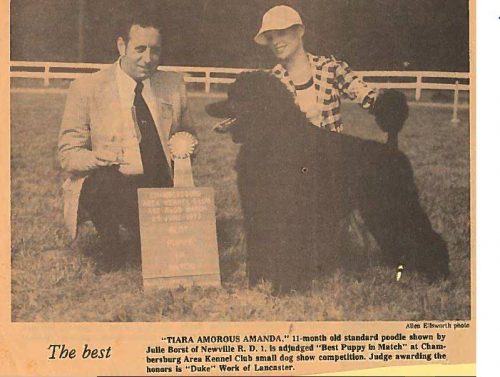
Breeder Spotlight #2 Tiara Poodles
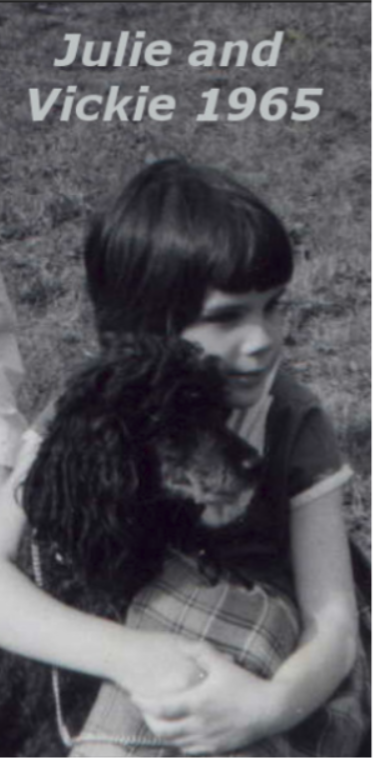
Champion producer, Gran-Ellen So Lovely Owner Edna McHugh. A beloved miniature Poodle named Vickie, my best pal while I lived at my grandparent’s kennel property.
What first sparked your passion for purebred dogs?
Simple answer: It’s in my blood!
My grandmother and her mother showed Cocker Spaniels from the 1930s till the “powers-that-be” changed the breed standard. People had to choose between Am or Eng. Cocker styles when the breed split. My relatives chose Poodles. This same great-grandmother’s father had imported English Mastiffs and she and her brother each had dogs that took them to grade school via carts.
From my ages of three to eight, my family and I lived with my grandparents on the estate of their show kennels/boarding facility and antique store. I learned to talk dog there and was my grandmother’s constant sidekick. I am the eldest of three children and when I turned four, the rule was put in place that you had to be four to be in the kennel. That age requirement went up along with each of my birthdays.
I was very responsible and loved the dogs and helping my grandmother. I was probably a pest following the kennel boys around to make sure they were doing their work properly! I helped with scooping and dinner pan collecting, water crock washing and I even helped answering the phone at a very young age, giving my grandmother a moment to get to the receiver. At the time (early Sixties) Grandmother raised Miniature Poodles she was having shown by Wendell Sammet (these wonderful people are still with us today and my MomMom is still 11 years older than Wendell).
My mother had owned a Standard Poodle before she went to college that had gotten a CD put on her by a friend of the family. I was told from an early age that someday my mother was going to get me a Standard Poodle of my own.
The family had been a refuge for Jim Clark (Rimskittle Poodles) for holiday dinners and then weekends at dog shows when he was in the service stationed at the relatively nearby Ft. Indiantown Gap. Considered a friend of the family, it was understood that my first Std Pdl would be chosen by Jim. But someone in the family forgot to tell Jim that information…..In the fall of 1970, we went to the Greenspring Poodle Club show to talk to Jim about a Poodle for me, “I can’t sell a kid a show dog” were his exact words in front of me. Things were WAY different for junior handlers in those days.
So my grandmother suggested Rebecca Mason of Bel Tor Kennels and it turned out that she had a co-bred litter coming up located closer to our region in the spring (she was in CT, we in S. Central PA). That litter went into a placental separation and the litter was lost. My mother, a school teacher that wanted the timing of the new dog to be coming home in June, made me wait 1 more year until this bitch brought forth some lovely blacks sired by Ch Bel Tor Big Picture and I got my first Standard Poodle in the spring of 1972. Talk about learning patience! Well, I wanted a purebred dog to show, in obedience and had found a Shetland Sheepdog needing to be rehomed that was originally from Lanbur Knls in NC, that kept me quieter about wanting to show my own dog during that LONG wait! I was 12/13 yrs. old.
What is/are your breed(s)? When did you start breeding?
I love nearly all breeds (having been a groomer for decades, I’ll admit though that Old English Sheepdogs make me glad I no longer have to groom them when I see them). Standard Poodles have been my breed since 1972. I bred my first Standard Poodle in the spring of 1975 and about a week before she was due to whelp, I had to go to Penn State for the State Dog 4-H competition. While I was gone, like her dam with her own first litter, my girl had a placental separation and the litter was lost.
Sire of the litter was 6 yr. old Ch Bel Tor Bringin’ Home The Bacon. When it came time again the next spring to drive to the Bel Tor Kennels in Pine Orchard, CT, Mrs. Mason wanted me to use an up and coming young do instead named Bel Tor Don’t Tread On Me. So, although I bred my first litter in 1975, my first litter born arrived the 20 th of July 1976. I was out of high school about 6 weeks at the time.
In all this reminiscing, I think of the great help given my purebred dog venture by so many and wish to give gratitude to my parents as well. My dad and his wife gave me great encouragement, buying me my first grooming table (Christmas 1972) and then my first Safari crate (Christmas 1973), they also helped to get me to shows. My mother gave me carte blanche to (clean and) remodel a large dairy barn and outbuildings on her property to house my dogs’ kenneling, she helped me get to shows and meetings, but was a single, working mother. It was special that she found time to sew a great crate pad for my first crate. I got to become the first ever Junior Member of the Chambersburg Area Kennel Club in the fall of 1974 and met some fine people in that club.
That 1975 trip to the State Dog 4-H competition was telling – I had not gone to enough county 4-H meetings like the first-place winner and was more or less explained that to be a deciding factor for my runner-up placement. I asked the winner what breed of dog she had and she said Poodle! That was cool, so excitedly I asked, “What variety?” Sadly, that stumped her. Although she had the qualifications for having attended and participated in 4-H events, having been driven all over her county and regional level meetings, she did not know the variety (Toy, Miniature, Standard) of her own Poodle and I am certain had not attended the national Poodle show (held in PA).
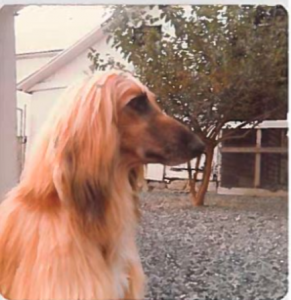 I worked to establish a boarding / grooming kennel during and just out of high school, paying as I went with money earned as an in-home groomer. I had fenced and mowed acres for the dogs and added some lovely Afghan Hounds in the Seventies along with the Standard Poodles. My first Afghan Hound, was from the first Kaihorn Kennels’ litter – Kaihorn Con Man. In this picture below too is the chicken house just behind “Huka” (he came with that name – it was the 70s) that I completely redid – roof, floor, walls and windows, added a 220 electrical line and put in a heater. This was the puppy house once they were old enough to leave our main house. Also, you can see the wagon shed that I fenced, which was ideal for ex-ing dogs in inclement weather which happens regularly in Pennsylvania. I put four very large in and out runs out the back side of that (left upper side of picture) where it used to house hogs. The tallest building, a bank barn, was a dairy barn on one side, had a horse stall and a sheep area as well. I turned the dairy barn side into indoor kennels – all this was done with customized Mason Modular Fencing from Ohio. My grandmother had used this same company for her kennels and I had seen it last and last.
I worked to establish a boarding / grooming kennel during and just out of high school, paying as I went with money earned as an in-home groomer. I had fenced and mowed acres for the dogs and added some lovely Afghan Hounds in the Seventies along with the Standard Poodles. My first Afghan Hound, was from the first Kaihorn Kennels’ litter – Kaihorn Con Man. In this picture below too is the chicken house just behind “Huka” (he came with that name – it was the 70s) that I completely redid – roof, floor, walls and windows, added a 220 electrical line and put in a heater. This was the puppy house once they were old enough to leave our main house. Also, you can see the wagon shed that I fenced, which was ideal for ex-ing dogs in inclement weather which happens regularly in Pennsylvania. I put four very large in and out runs out the back side of that (left upper side of picture) where it used to house hogs. The tallest building, a bank barn, was a dairy barn on one side, had a horse stall and a sheep area as well. I turned the dairy barn side into indoor kennels – all this was done with customized Mason Modular Fencing from Ohio. My grandmother had used this same company for her kennels and I had seen it last and last.
I mainly wound up doing rescue for the Afghan Hound breed after following a mentor that led me into a genetic mutation that killed most of my third litter of Afghan Hounds…..that was so heartbreaking, I stopped flat in that breed, but still admire them to this day. The Standard Poodles were so much more predictable for basic health and less heartbreaking at the time. Must mention something particular to my breeding program since those times, is that I have always named my Poodle litters using the alphabet system A-Z and have now gone through the alphabet several times. Going through the alphabet especially as of late with more Tiara co-breeders working in effort to help rebalance the gene pool. I keep to the same naming pattern for my own dogs of any litter. We also have a Beatles’ theme line in the alphabet scheme as well as a Pearl Jam theme and a Patriotic theme. I have registered full litters since 1978 due to someone that changed the name from that which was written on the AKC registration application “blue slip” (we used to use) of the D litter to: Tiara Katie …..who got her UD… no kidding. Wasn’t just a pet pup – I got to see her in the local dog show catalogs for years! But it taught me a lesson and I have registered every puppy first to myself going forward; no blue slips out the door, registration transfers only for FORTY years!
Now the AKC has made it deluxe in that I can register the entire litter and register the puppies and their microchips to the new owners as well. This takes a bit to have the pups settled in their new homes but is all done with one form submitted and then the completed paperwork leaves AKC and goes directly to the new owners. Perfect!
Jump to the summer of 2003, my husband Kirk Reed and I were showing at UKC shows regularly because we had (truly) outbred to a Standard Poodle from Latvia named Arbait-Zarembo (who resided with his owners in Ontario, Canada). We had litters sired by him in 2000. Then in 2001, AKC told us after those first 2 litters born in 2000 were applied for registration, that they would not accept the stud dog in their registry (because he was from the old Latvian registry). Nonetheless, the Canadian KC readily accepted this Latvian Standard Poodle after sending three Poodle judges to view the dog at his home and verifying his pedigree. He was instantly registered upon the judges’ evaluation. I told the AKC that what I was doing was not Fifi bred to Pierre; that Standard Poodles greatly needed the genetic diversity and that there was quite a bit of effort in breeding the dogs on opposite ends of the continent (sending bitches from San Diego, CA to Ontario, Canada) but it was worth it. The man that spoke to me at AKC was uninterested in any of that, gruff and stern. Thank goodness it is not like that anymore at AKC.
In addition to those more outbred, full Standards produced in 2000 and 2001, in 2002 we blended Miniatures in with our Standards for guaranteed genetic diversity. Many of the UKC judges listened to why our Std Pdls were smaller than average while we enjoyed the dinner get togethers here in Southern California and in Phoenix, AZ as we mostly showed in these regions. I never stopped talking about the importance of genetic diversity in a breed/variety with a severe genetic bottleneck…..like the Standard Poodle. I knew, with Dr. John Armstrong’s guidance, that I was on track for the right goal of working to rebuild our Tiara Line’s genetic foundation.
Also, in UKC, if it states the breed or variety is a particular height, they follow the breed standard to the letter. That was always deeply appreciated at the UKC shows and you would not see anyone fudging an oversized of one variety, say American Eskimo or Alaskan Klee Kai, into the smaller variety like you do in the AKC Poodle ring. What the dog measures, is the class in which they are exhibited; no fuss. My “Libra being” is thrilled with rules followed.
Without question, our smaller Standard Poodles were better accepted at UKC then they would be in AKC conformation, so we went to UKC shows often that decade and got to see a lot of the rarer dog breeds while competing in that venue.
In the early summer of 2005, we were charmed by a gorgeous, 6-month-old Alaskan Klee Kai puppy named Kassie – we told her owner, we wanted a show puppy female from her when there was one to offer. In late December 2007 Damara (named for dog show legend Damara Bolte that I have admired since first meeting her with her Basenji in the mid-70s) was born and she came to be our foundation in this charming breed in which we now may co-breed puppies about once a year. That charming 6-month-old named Kassie did go on to capture the #1 spot for the breed one year and #2 another for her owner Desarie Fletcher. She was just beautiful to watch show and I was honored to take her in the ring on a few occasions. It was because of my close association with the Alaskan Klee Kai breed, that when the chairman of the health committee, Sheila Sweet, began discussing an upcoming project with OFA that I suggested she look into the UC Davis Canine Genetic Diversity DNA test that the Standard Poodles just acquired earlier that month (first offered Jan 8 2015). Sheila went to work and just after the Italian Greyhounds acquired the test in March, the Alaskan Klee Kai acquired the test in April 2015! The Breeders of the Alaskan Klee Kai have done a fabulous job with this breed and this year the parent club turns 30 years old.
Who were your mentors?
Rebecca Mason, Bel Tor Knls – 1972 through @ 1978 – breeding
Mary Peacock, Davaroc Poodles – 1978 through @ 1983 – grooming, etc.
Elizabeth Campbell, Dhubne Poodles – 1985 – DO YOUR HEALTH TESTING!
Dr John Armstrong, Canine Diversity Project & his (Poodle) people –’98-‘01
Natalie Green Tessier, Better Bred – 2012 – present
Sheila Sweet, FOXX Alaskan Klee Kai – 2015 – present
Mutual mentor, Lori Miller, Desert Guide Breeding Dir. – 2015 – present
We all grow and change as we learn more as breeders. When you first began your program, what was your goal?
To produce the #1 Standard Poodle in AKC conformation; that was a childhood goal (spurred on by being turned down by Jim Clark for one of
his Poodles when I was 12 yrs. old. Let’s say I see both sides of that situation clearly, but that incident was certainly a driving force for my goal).
What might you say is your focus for your breeding program now?
Complete package of Health, Character, Conformation, as before, but add the documented Genetic Diversity DNA and the ability of many of our
Poodles to be a help to mankind as Service Dogs. Working with the Guide Dogs of the Desert the last few years has shown me the importance of
good depth in the trait of stability, more clearly than I had grasped before. I thought if the dog did well in public, shows, agility, etc., that showed
stability, but there is quite a bit more to what is needed as a successful leader dog for the blind that includes a deeper willingness-to-please with
intuitiveness. We’ve had that in some of our dogs, but now it is an important character to better establish and maintain for us.
How has your goal changed, and if it has, why has it?
My educational evolution in Poodles I know has been accomplished by goal setting, achieving a major goal and then looking to where I could do even
more good from my study and that involved setting off into an almost entirely new direction along with retaining the important lessons learned
over the previous decades.
In 1991, all was “mainstream” showing and moving right along at Tiara Poodles. Six AKC champions bred by me were on course to finish in one calendar year, I was focused. Then in October, an apricot Standard Poodle pup was born from several generations of black. Everyone was asking me, “Where did that come from?” I didn’t know the answer. So, I set out looking into the Poodles in America volumes and started checking colors on the dogs in our pedigree. Found the apricot behind the wonderful Ch Dassin Debauchery fairly easily. Then I noticed something in that book of pedigrees that changed the way I looked at Standard Poodles forever. Over and over the same dogs were in pedigrees of that era and it looked like a misprint! Although I found the answer about color that I needed, I was also finding out the disturbing fact about the bottleneck inbreeding and that initially sparked my deep desire to mitigate the potential, implicated risk that Biology 101 teaches regularly comes from so much inbreeding. This is seven years before I had a personal computer. So, by hand, I set out to go as far as I could behind every line I could of the generations behind Dassin Debauchery. This dog was born 20 years earlier than my study and I had cheered him on to Best of Breed at my first PCA national in 1974. He was a top producer of his time and the sire of my foundation bitch’s dam. I felt a connection with him and wanted to know well his pedigree. I had to know all I could and it wasn’t looking good. It took several weeks, but when I had traced each line as best I could, going as far back as I could, I came up with over 300 lines back to a dog named Clown von Rapollo born in early 1922, only about 50 years before Debauchery. Over 300 times…
In 1995, I worked to open my gene pool two ways. I used a slightly less related dog (per pedigree) from England. Man, did we get gorgeous teeth – like Airedales – I Iiked that as an improvement and I appreciate holding onto that sound dentition in the line. Also, earlier that year, I used a dog at stud that was 9 years old and his sire was 9 years old when he sired him! I was very happy with my pick females from each of these litters and they are prominent in our pedigrees today (and pictured below).
In the meantime, a dog from three generations of my breeding born in 1992, produced with Kay (Palade) Peiser as co-breeder, achieved AKC #1 Poodle conformation showdogs (all varieties) in 1996. Childhood goal achieved! With that 20-year-long goal accomplished, it almost felt like empty nest syndrome. I had to set a new goal.
I had been trying to find out what I could about diversity in pedigrees and it wouldn’t be until I got a personal computer in 1998, that I found “my people”, in the Canine Diversity Project, headed by Dr. John Armstrong based in Canada.
Kathryn Foran on the Canine Diversity Project told me about the Cadbury dogs in Colorado, that pedigree-wise, (at that particular time) had less of the Mid-Century Bottleneck genetics compared to the average (again, pedigree wise, we did not yet have the wonderful DNA test to verify diversity). We utilized Ch Cadbury’s City Slicker for three litters in 1999/2000 bred to those pick of litter girls born in 1995.
This was time to really start working that new goal! Someone on the Canine Diversity Project email list had located Arbait-Zarembo, a dog that immigrated to Ontario, Canada from Latvia with his owners (they were fleeing Communist rule) and who reportedly had a very rare pedigree, maybe even devoid of Wycliffe lines. Without hesitation, we bred to the dog three times and went forward with one female very successfully of the 2001 litter and we have one male out of Karisma’s 2000 litter sperm banked, not yet used, but I see him fitting in well soon. We certainly would have done more with at least these two litters, but AKC wanted this stud dog re-registered in the new Latvian kennel records and the owners did not wish to do that.
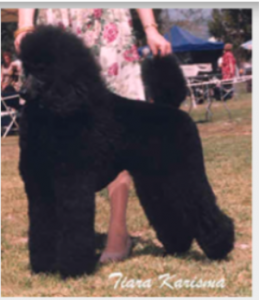
Tiara Karisma, CHIC – born May 7, 1995 – “Kelly” was bred successfully to City Slicker, Arbait-Zarembo, and to the Miniature, Baroque Romeo, CHIC
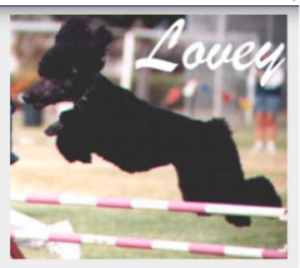
UKC AG-2, MBIMBS GRCH Tiara Love Me Do, CHIC AX, AXJ, NP
born August 18, 1995 and outbred successfully to City Slicker, Arbait-
Zarembo and the Miniature Poodle, Baroque Romeo, CHIC
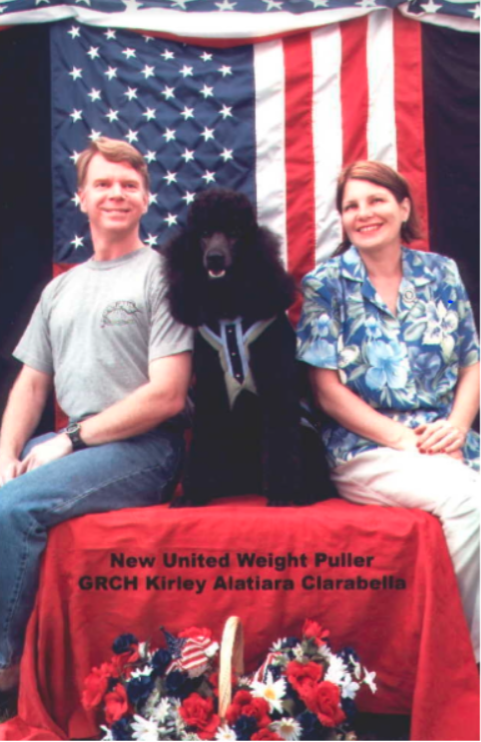
UKC UWP MBIMBS GRCH Kirley Alatiara Clarabella, CHIC first generation born for us in Canada on July 7, 2001 – born in Canada because it took AKC 10 years to change policy and accept these very dogs – not because we wanted to drive to Canada! Pictured achieving her UKC weight pull title with owners Kirk Reed and Julie Borst Reed. Sire Arbait-Zarembo / Dam: “Lovey”
So, off to Canada we drove on the 4th of July, 2001 in a rented motorhome so that our pending pups could be born in Canada and obtain Canadian KC registration. We were promised that the third generation of this effort would be accepted for AKC registration. No one in my local Poodle club knew that a dog with Canadian KC registration did not automatically mean AKC registration of its offspring – including me. We persevered.
Dr Armstrong told me that I would have to utilize Miniatures with my Standards if I wanted to keep producing outcrosses, that now there was nowhere else to go in Standard Poodles to be sure you were outbreeding.
“WHAT? Are you kidding me?” I laughed. I was not about to take my winning line of Standard Poodles to Miniatures! <sigh>
But, alas, in no time, I saw the light, Dr. Armstrong was right. As of 2002, all Standard Poodles of breeding age (and decent health testing) were related per pedigree, closely related, and this was the case all around the world. We later learned that the COI (coefficient of inbreeding) formula we were using at that time, is simply an estimate and was not a true measure of genetic diversity for the Standard Poodle variety due in part to the severe genetic bottleneck stemming from the 1950s. A few breeds can still see benefit from last century’s Wright’s Coefficient of Inbreeding calculation, but it is
proving to be less effective in holding on to diversity for most breeds.
I inquired to several Miniature Breeders about fully-tested studs for my fully-tested Standards, but like I thought the suggestion at first was ridiculous, so did they, even more telling is that I heard back that I was ridiculous for suggesting this. Thanks Fancy, way to accept science is what I thought of that attitude, but to be fair, it took me a bit to understand the importance of what science was showing us at first too. People that do not educate themselves on the true situation often have the attitude that nothing is really wrong. Also, there was concern expressed to me that Standard problems would go into Miniatures. I never intended to be producing Miniature Poodles and to this day, I have not.
The classic statement and never-to-be-forgotten by me is this reply I heard to my inquiry for a Miniature stud dog by a man on the phone, “WHEN something goes wrong, you will post it all over!” The word when was very telling to me and I quietly thanked the Poodle gods for inspiring me to keep shopping.
The Miniature Poodle gene pool did prove to be as unrelated as another breed per Dr. Pedersen, et al’s. research into the gene pools of Standard and Miniature Poodles (per the peer-reviewed paper of August 2015). Dr Armstrong had been right nearly 20 years before when he was encouraging Standard Poodle Breeders to re-dip into the Miniature gene pool. Proven with study of Poodle pedigrees, these intervariety matings are seen as a choice in selections that was regularly done until the 1950s. Breedings between Standards and Miniatures and even Toys were not uncommon (Miniature and Toy intervariety matings went on as not particularly unusual for 20 or more years after that). Reportedly, a tall Standard Poodle in the late 1930s was 20 inches tall. The 1950s – the birth decade of one of the most studied, human-manipulated, genetic bottlenecks in purebred animals done to our Standard Poodle gene pool.
By the way, these combinations we produced with intervariety breeding are/were some of the finest Poodles I have ever met and I have met a lot of Poodles having eagerly attended the national Poodle show (PCA) for 22 years in a row where I learned a lot and personally met a lot of the dogs in today’s pedigrees.
Now it has been 22 years since I have attended…..some reasons for that:
1) I barely can tolerate flying (have flown only a one hr. flight to AZ in the last 12 years or so – where I got so nervous, I took the arm of a stranger across the aisle AND I drove back instead of getting back on the plane. I probably really am one of those that needs a stress-reducing pet along with me, but I have looked to avoid flying all together instead).
2) That there is no longer the stud dog shopping that I enjoyed for designing my line circa 70’s/80’s/90’s (which, “my line”, turns out to be not that much different from what anyone else was doing in those decades per DNA that can be determined. Instead, I stayed away, I didn’t keep breeding to the same descendants and looked for outcrosses and may have held onto some genetics of those older dogs by doing so but avoided the best I could doubling up on some of the popular sires).
Hopefully the situation of what is selected for breeding changes more before I die and a wave of genetically diverse dogs, show-stylish and performance-proud hit our national Poodle show for the betterment of the gene pool. The betterment will prove to be the genetic diversity conserved and available in the gene pool so the variety will thrive for decades to come.
Those of us who have been breeding awhile know it can be a rocky road full of challenges. Has there been a time while breeding dogs that you considered quitting?
I would say 1978 and 2004 while fighting viruses in young dogs – we are so respectful of those.
And I did drop the Afghan Hound breed in 1982 due to misrepresentation by a mentor where a known condition (the internet later proved the line was known for this, but I didn’t know it at the time) that over a few agonizing days would paralyze the puppies to death, destroyed all but a few of some wonderful, gorgeous puppies in my third and final Afghan Hound litter. One of their stud dogs was the sire to the dam I had produced and she, in turn, was bred to another of their sires also at public stud. Just heartbreaking.
Also, I have to write that having to sell some of my favorites from time to time too is difficult, as you cannot keep them all, but man that is hard (even just thinking of some of these friends now is a heart tug). I work hard to find great homes and I appreciate those, you bet! We have an email group of “Tiarans”, consisting of our Poodle owners that desire to join and it is nice to share information back and forth there and keep tabs on the dogs. It also proves a great support group in good times and bad.
What are some of your high points as a breeder?
Several wins at the national Poodle show (PCA) – Best Standard Puppy, Best Veteran, Best Brood Bitch, Winners/Reserve Winners Dog(s) even class placements were some of the best times. I grew up with the annual show at Ludwig’s Corner, PA and made a number of wonderful friendships in the Poodle World when I was regularly attending the national.
*****************
A major high point wa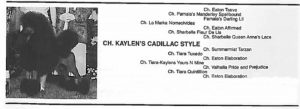 s achieving my childhood goal and co-breeding from three generations of my females, Ch Kaylen’s Cadillac Style, CHIC and watching him enjoy a successful career to achieve # 1 Poodle all varieties ’96, lovingly handled by his co-breeder; always able to be with his special person his entire life, a real plus for the dog. I am also very proud that he has produced well, but I have never been able to incorporate his blood, because it would be too related. Hopefully someday that step will prove to be a viable option.
s achieving my childhood goal and co-breeding from three generations of my females, Ch Kaylen’s Cadillac Style, CHIC and watching him enjoy a successful career to achieve # 1 Poodle all varieties ’96, lovingly handled by his co-breeder; always able to be with his special person his entire life, a real plus for the dog. I am also very proud that he has produced well, but I have never been able to incorporate his blood, because it would be too related. Hopefully someday that step will prove to be a viable option.
******************
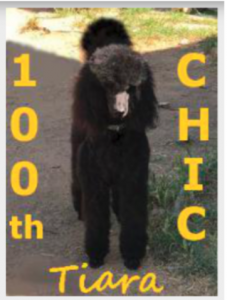 Another heartfelt accomplishment is that in May 2018 – our prefix “Tiara” had the 100th CHIC designated, #129505! What a fantastic feeling of accomplishment and camaraderie, as so many of these Standard Poodles had their testing accomplished by their owners who promised me that they would. Thank you to those owners!
Another heartfelt accomplishment is that in May 2018 – our prefix “Tiara” had the 100th CHIC designated, #129505! What a fantastic feeling of accomplishment and camaraderie, as so many of these Standard Poodles had their testing accomplished by their owners who promised me that they would. Thank you to those owners!
Number 100 is named in honor of Kay Peiser, Tiara K In Oh So Many Ways Moonstruck, CHIC, CGC, TKN owned by Eleni Stevens, Moonstruck Poodles. I wrote to Kay two years ago, to let her know this pup reminded me of her – outgoing, smart and just a bit entertainingly obnoxious! With me, this Poodle’s call name was Kay.
Her new owner chose “Ava” as the Poodle’s call name. Ava has recently been bred to the frozen semen of a healthy, 14-year-old grandson of Arbait-Zarembo. This particular stud dog is full size and is thus far, healthy at 14 yrs. https://www.ofa.org/advanced-search?f=sr&appnum=1136211
His sire is from more mainstream pedigrees, but his dam the daughter of Arbait Zarembo. All breedings are a bit of a gamble as to what you may produce in the get, but these numbers are looking rather good for what should be full size. Here, look at how nicely I can share such detail with this chart from the BetterBred application:
Picture below was taken the day before insemination of that breeding, the sperm stored in this tank since 2005 waiting for their chance to fertilize eggs. Pictured May 2018, is Carol Bardwick, founder of Canine Cryobank, San Marcos, CA. Carol and her dedicated team have helped us with progesterone testing and sperm counts and storage for over 20 years. We now have 8 dogs stored here.
Our young showdog paired with this bitch instead (https://www.ofa.org/advanced-search?f=sr&appnum=1918865 ), increased the OI predicted average for the litter to .38. That is a great plus, but the average IR fell a bit in worth to over 0, so the part about being 14 yrs. old and still very healthy helped tip the scale in selection to the geriatric as the choice stud this year. The added tool we have using the BetterBred application with this science is almost priceless. I love it.
********************
October 11, 2010, the first day AKC Breeder of Merit status was issued by the AKC, I was honored to be named. I believe Eva Marie Mitchell, Dreem Poodles was, too.
November 7, 2017, the first day the Advanced AKC Breeder of Merit was issued, I was named AKC Gold Breeder of Merit status and was extremely proud. We have 45 AKC (prefix) champions, including a MACH 8 and a MACH 11, both who have passed from Earthly existence just this year and are dearly missed. Also, there are 29 AKC, Tiara-bred performance (suffix) titles also credited to me as their breeder. Here is “Lovey” with a collage of her agility offspring of days gone by. To note, D’Aire, still with us, now 16.5 yrs. old with the Seeley’s in Southern NJ.
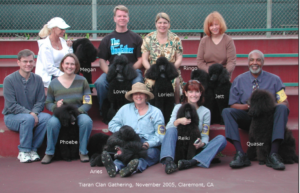
Additionally, our Miniature/Standard combinations since 2002 were not going to fit in at AKC conformation, but fly they did at UKC. Lots of fun for our family of our Tiarans. Here is a gathering at a UKC show in SoCal. Lovey, Lorelei and Aires are full Standards; the others have Miniature influence up close.
*********************
In UKC, oh, remember we had no choice but to exhibit in UKC conformation because AKC did not accept the Arbait-Zarembo offspring? For 10+ years we worked on this, as AKC had told me I needed to have three generations born in Canada where Arbait-Zarembo was registered to then bring the third generation into AKC……. We had two generations born in Canada at a cost of about $10,000.00 each effort to us (we live 24 miles north of Mexico)….then, a magic wand at AKC waved over our work and accepted ALL the dogs – “poof.” Would have been nice 10 years earlier, but at least the wand saved us the third venture into producing another generation in Canada! So, I am proud we brought in this very rare Standard Poodle from Latvia to AKC registratio
To note, breeding the Miniature to the Standard only ever produced Poodles of 16” or above for us, which made them Standard Poodles and that is how they were registered.
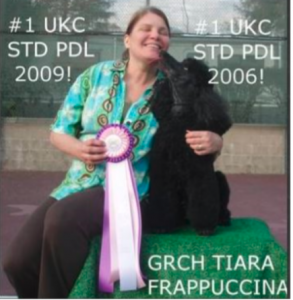
Our UKC 12XBIMBS GRCH Tiara Frappuccina, CHIC – a favorite girl! Baroque Romeo, CHIC x Tiara Karisma, CHIC
In UKC, in the Standard Poodle breed, we have 35 Grand Champions, 18 Champions and another 10 dogs with performance titles credited to Tiara as Breeder. That includes two weight-pull titles my husband and I enjoyed training and competing with Clarabella and the real star, D’Aire. Many of these dogs were shown by their owners! We bred the #1 of the breed in 2006, 2007, 2009 and 2010 with #2 UKC Std Pdl in 2004, 2008 and 2011.
These top spots were garnered by Standard Poodles (solid-colored) ranging from 17” tall to 24” tall.
And just recently, the new Poodle Club of America “Illustrated Study of the Poodle Breed Standard” has been offered – congratulations to all involved in that spectacular effort for the breed’s concern. I was so impressed with the entire presentation. Then a longtime Tiara owner and co-breeder called to tell me the identity of the dog on the back cover retrieving a duck – he comes down from our efforts – thank you Kris Bucheit! His name is Chase http://www.phrdatabase.com/cgi_bin/pp_pedigree.pl?id=263194
You were one of the first to adopt a controversial idea in Standard Poodles: intervariety breedings. Why did you venture down that path?
I was absolutely in search of genetic diversity within the breed to avoid producing Addison’s disease and especially bloat …..remember, I researched Standard Poodle pedigrees behind Dassin Debauchery by hand in 1991. That was a VERY telling exercise. Also, and mainly because Dr. John Armstrong, Canine Diversity Project, explained to me what little diversity was left as KNOWN per pedigree analysis at the time in the Standard Poodle gene pool. Sadly, we lost Dr. Armstrong in the fall of 2001. In January 2002 our D and E litters sired by a Miniature and produced out of our Standard dams were born. They were wonderful to behold! Some of these Poodles of these two litters are still alive and well at this writing in 2018: Those whose owners have kept in touch: D’Aire of the D litter 2002, is loving her retirement in southern NJ and Ester of the E litter 2002 with lots of agility titles lives in San Antonio, TX. Each of those girls lost at least one of their 16-year-old littermates just this spring as well.
Such great Poodles – thank you Dr. Armstrong for the right direction for diversity.
My special thanks also to all that supported us in this endeavor. I was especially proud that the research done by Dr. Pedersen, et al., highlighted the intervariety-produced Poodles, their DNA results and how they were/would be instrumental as a purebred means of bringing in some needed genetic diversity to the Standard Poodle gene pool. Even though Standard Poodles have good depth of genetic diversity available, it is not utilized properly with 70% of the population in a glob of relatedness, as their parents are at least as related as half siblings. That is the situation around the world; a lop-sided gene pool with 70% in a deeply-related situation and 30% of the population with 70% of the diversity! No going off to the Congo like Damara Bolte and my longtime friend Michael Work and bringing home unrelated dogs to boost a gene pool, as these fine people wisely did for the Basenji. We are very fortunate to have a variety within our breed to turn to that is as unrelated as a different breed – the Miniature. We are also fortunate in having 30% of the gene pool available to help to rebalance our precious Standard Poodle gene pool.
Can you tell us what benefits and negatives you have found in those
breedings? What about long term health?
Well, the obvious negative is the size is reduced. I do not breed for a particular size, but I had a decades-long reputation for raising nice, 22 – 26-inch-tall Standard Poodles and not every client was ready to go smaller (a lot smaller), not even for statistically, greater longevity…..but God bless those that were/are!
The other negative was that Dr. Armstrong had gone to the next realm and Dr. Pedersen had not yet made the scene and wouldn’t for a decade, so from 2002 – 2012 I had just a bit of support overall. We certainly celebrated when Dr. Pedersen’s work was published in August 2015. Finally, the science was there in black and white, peer-reviewed and funded by the Poodle Club of America Foundation: The findings confirm that the intervariety breedings are genetically very worthwhile to the Standard Poodle gene pool.
There were many years of rather going it alone; but I knew in my heart this is what I wanted to contribute AND I could sleep at night knowing I had done everything I could using dogs within the breed to avoid producing Addison’s and bloat in the Poodles I was offering to the public. This brings to mind the saying, “Not all dog Breeders have to breed alike; that has been done already!” And that not all Breeders need to work on genetic diversity, but many should make an effort to rebalance/redistribute what genetic diversity is available to unclog that 70% worldwide condition of being so closely related.
I thought it would take me 10 years to get our Tiara line back up to size overall, but it is now 16 years since the first intervariety litters of 2002 and not all the Standard Poodles we produce today are expected to mature over 22 inches…..but some are. Which makes me smile to type.
There is no doubt that I am in love with the diversity and the character of these Standard Poodles with Miniature influence up close. Something many Poodle Fanciers do not realize is that all Standard Poodles have Miniature and even Toy influence in their pedigrees; all Miniature Poodles have Standard and Toy influence; and all Toys have Miniature and Standard influence. Incredibly, just in the past few weeks we now see DNA results for genetic diversity in Toy Poodles and the majority of the genes of those tested thus far, fall decisively BETWEEN Standard Poodles and Miniature Poodles. <eyebrows raised>
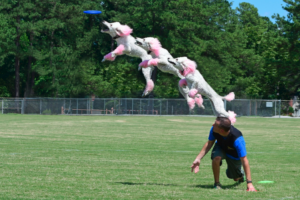
Tiara My Belle AXJ,XFP,AXO,CGCA,CAX#,DJ,UJJ,UJJCH,CJJCH,LAX, FZB “Jolene” http://poodledata.org/pedigree.asp?ID=427176
Recently the #1 Disc (Frisbee) Poodle we proudly bred, who is now out of Florida AS well as we bred the year’s fastest Fly Ball Poodle who is out of SoCal (and 2nd fastest in history). These girls were from our intervariety pairings up close in their pedigrees. So, they are superb athletes to boot! I encourage those working with these combinations to be certain to obtain health clearances on those to be considered for mating. I could go on and on about how sincerely I have been delighted with these Poodles and how terrific these intervariety-bred Poodles really are, but people also have to know that it is very important that one must research and health test and post breeding candidates as CHIC designated dogs with passing results before you bring any dog into your program. I have not taken short cuts and I hate to see those taken by anyone when our gene pool is at stake.
Now, we are literally inching our way back to regular-size Standard Poodles WITH impressive genetic diversity. I may always have a line carried on of the smaller friends of the Standard Poodle variety with incredible diversity; time will tell. The super-outbred, smaller males bred with larger females seems to be a good plan to produce greater size overall sooner considering the Miniature influence is right there. The director of breeding with a local guide dog organization is successfully going with that plan with a few Standard Poodles in their breeding program today. I am thrilled to assist this intelligent group of devoted Breeders headed by an outstanding director, as they take no short cuts and have embraced the goal of genetic diversity in the dogs they produce as well as now feed their dogs used in breeding a raw diet.
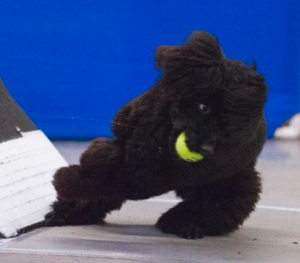
UNJCH Tiara Z Hapitauk Star Spangled Victory, CHIC FDX MBDX NW1 IN VN CN CGC “Tori” http://poodledata.org/pedigree.asp?ID=440044
As for long-term health, I am happy we seem to be on our way in achieving that overall. I am thrilled that we can better avoid Addison’s and I believe also bloat. I used two different American Miniature males (1 was of more common lines and one with Toy up close) and we also imported a Russian Caniche Moyen stud, making certain they all passed health scrutiny before breeding into our program.
Again, I wish to deeply thank all that have supported this work, not just those within our direct efforts, but everyone around the world working to rebalance the Standard Poodle gene pool. That cooperation to me is the purest benefit, to answer the posed question directly.
In the years to come, when someone is writing the history of your breed, how would you like to be remembered?
I wish to be remembered as determined to do right by the breeds I loved.
We, obviously, are a company that empowers breeders to be conservators of their breed’s long-term diversity and viability. How do you use this in your breeding program?
I am thrilled to be able to acquire mate pairing statistics through the BetterBred application. Then, once we have a litter arrive, I admit to rushing to learn the entire litter’s Genetic Diversity DNA test results as uploaded to Better Bred. Those final DNA figures posted to BetterBred are the product of this well-thought-out tool that many conservative Breeders are now using in selecting weanling pups to be considered as held back for further evaluation. These are abilities that were only dreamed about even in the recent past. Thank you!
Since using BetterBred, have you had any exciting keepers you would
like to brag about?
Oh yes. One particular female’s results brought tears of joy when they posted to Better Bred! When you work so hard to achieve something so difficult as genetic diversity in a serious AKC Standard Poodle show prospect, well, it was a bit overwhelming not only for what that diversity means to our own success in offering diversity in our line, but what it means for the breed. I wish Dr Armstrong could know about her, as he challenged me to produce a winner with outstanding genetic diversity.
Well, she has the diversity, time will tell if she will be a winner. Producing a litter with full Standard Poodle size and all the outlier indexes above .40 would be dreams come true for my husband and me. AND if we can keep the IR’s under 0 at the same time we do that, I we will deserve a trophy! LOL Actually, I think dogs achieving success in conformation/performance events and being over a certain level of outbreeding should be honored to better highlight them for consideration by other breeders.
I believe that all breeders should at least LOOK at their litters’ genetic diversity so they do not miss something so exceptional in what the conservationist Breeders view as important. I wish to encourage everyone in purebred dogs to work at this and for those shopping to know what exactly is being offered them per the DNA as well. We have the science, I am thoroughly on board and delighted to utilize this. I talk about this subject a lot every day and it was pure joy when a second-generation person (a person that had been mentored by someone I mentored) started discussing the subject with me with as much enthusiasm as I have for the testing. It is fabulous when you are checking your new litter’s results and it is like opening wished-for presents at Christmas! It doesn’t always go that way, so it is that much more rewarding when the numbers all fall close to where you want.
Do you have plans you’d like to share about your breeding program?
Just happy to work fine tuning and slowly having more full-size, good looking Standard Poodles of impeccable stability and athletic ability to offer with incredible genetic diversity – oh (I am smiling at that tall order) AND raw fed with fresh food ingredients for several generations. I am very happy to work with other Breeders and to help develop new Breeders seeking diversity. I look forward to the day the gene pool is better balanced in Standard Poodles and there are more selections available that I am comfortable with outside dogs away from our own breeding.
I may always also have the smaller Standard Poodles too, as their size is more historically-correct (actually), they are practical (and charming) and deeply appreciated at grooming time as I age! Those that have known me since my Jr Handling years don’t want to know that I am about to turn sixty this fall (2018)!
In the Alaskan Klee Kai, I look forward to the day they become AKC registered and I hope more and more Breeders come on board to glean the more diverse genetics still available before AKC recognition. I am anxious to show them in AKC, but rethinking this, it is probably better to stay away from AKC until more people are breeding their Alaskan Klee Kai with the genetic diversity better documented and with conservation in mind. Greater genetic diversity, statistically equals greater longevity and is my mantra as primary goal for the dogs I bring together. I suppose part of my new goal is to regularly produce above .40 Outlier Index with 0 or lower Internal Relatedness in both breeds. That will take (us) a while. Want to help?
And finally, do you have words of wisdom to impart on those who have not been in the breed for long? Somethings you might have liked to have heard, or maybe should have heard?
1) SHOULDERS/front assembly needed for proper athleticism and gait.
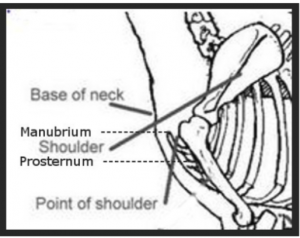 An important aspect for most dog breeds is that the top point of the prosternum, called the manubrium, needs to be in front of the point of shoulder. This is essential in either of my chosen breeds. Sit up straight yourself, shoulders back. Your sternum is in front of your shoulders. Feels good to have good posture. Well, if you make your shoulders in front of the sternum, you have improper posture …..but hopefully you can sit back up and fix that. Many dogs do not have that option and then are asked to jump in sporting events. They can’t jump well if built like that and mostly bunny hop over obstacles, having the rear do all the work. The shoulders should work in taking a jump by helping the front legs reach forward and in pulling the body up and over in concert with the rear legs’ propulsion. Slow-motion recording is a great assistance in learning just what the dog is doing in jumping or trotting.
An important aspect for most dog breeds is that the top point of the prosternum, called the manubrium, needs to be in front of the point of shoulder. This is essential in either of my chosen breeds. Sit up straight yourself, shoulders back. Your sternum is in front of your shoulders. Feels good to have good posture. Well, if you make your shoulders in front of the sternum, you have improper posture …..but hopefully you can sit back up and fix that. Many dogs do not have that option and then are asked to jump in sporting events. They can’t jump well if built like that and mostly bunny hop over obstacles, having the rear do all the work. The shoulders should work in taking a jump by helping the front legs reach forward and in pulling the body up and over in concert with the rear legs’ propulsion. Slow-motion recording is a great assistance in learning just what the dog is doing in jumping or trotting.
2) Another important lesson is to know what to SEE in the side gait picture to better know how a dog is constructed. Yes, you want a smooth, seemingly-effortless gait.
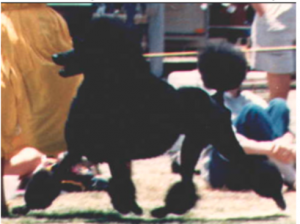
This AKC champion I showed in the 1980s was singled out at a George Alston handling seminar for the folks to study for his balance –
Effortless trotting usually means everything is put together in a balanced fashion. Balanced footfall must be the PRIORITY – before the reach and drive you no doubt want to look at first….but remember the priority.
Do a search for: ‘Horse Gaits — Footfall: Emphasis on the Diagonal’ and study the trot – the first 1 minute, 55 seconds of the presentation is the part to study. A well-built dog will trot with a two-beat trot as demonstrated (by nearly all horses). It shows the dog is constructed with balanced conformation “fore and aft” (the front and rear angles of structure in shoulders/elbows are of similar angles and thus complimentary to balanced construction of the angles of the hips/knees). If not a two-beat trot, not a balanced dog and there are many not doing a two-beat trot that you will see once you have trained your eye. The real eye opener is to watch a recording of dogs trotting at a show in slow motion. A two-beat trot is very easy to understand. Out-of-rhythm legs are not efficient and without a solid trot, it’s tiring and the dog most likely will then be easily observed in a few short years as not able to “go all day”. These dogs with mismatched angulation are not natural athletes and essentially incorrect for the majority of breed standards.
3) So, yes, go to seminars, study, study study everything about your breed.
Learn about the importance of diverse genetics, why diverse genetics is valuable to not only the gene pool of your chosen breed, but how genetic diversity (statistically) will help you produce greater than average longevity in the dogs you produce to share with others. Better Bred has a very good introductory class. I suggest if your breed is one of the breeds that has the test available, that you run a test first so you can utilize your own dog’s results to study as you learn. In my experience in helping people learn about this science (that I wished for ; ), I see that folks seem to learn more easily when studying their own dog’s results. Hey, if your breed is not yet a part of the research to develop a genetic diversity DNA test, I suggest you look into what you can do to help that get started.
Back in the Canine Diversity Project days I asked who among the members would like to be a part of an international conservationist dog Breeder’s guild. A few people replied they would, but the email list had greater staying power and already suited as something like that just fine and my idea waned. When this DNA test was created, it seemed we needed an all-breed place to discuss results and to help additional breed fancies come on board. So, in June 2015 I started the Canine Genetic Diversity DNA Test discussion group on Facebook. It turns out to be just about what I was looking to create in an association of sorts to help dedicated purebred dog. Breeders gather in concern for gene pool conservation. We just had member # 2000 join! I am suggesting that is a good place to come learn more about what is going on in diversity DNA testing among a “diverse” group of dedicated purebred fanciers. It is a place to ask questions, share ideas, cheer on new breeds joining and stay in touch of new developments. It also has the ability to help bring people together of a particular breed that want to start looking into developing the test with the Veterinary Genetics Laboratory at UC Davis.
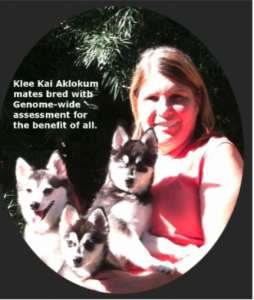
We have one GRCH in Alaskan Klee Kai and produced a daughter and a granddaughter with best female wins.
4) And finally, if you run into a dog with a poor condition, start again or breed way around it. Back up, go another direction or do not hesitate to start over. Study, save up to purchase the best your study shows you is a good step for a sound foundation in your breed. If your breed is riddled with (a) particular condition(s), do you really want to perpetuate this? Work to find an answer; lead, volunteer assistance to the national health committee, organize to have research funded for this condition and stay with these projects for the love of your breed.
Personally, I had three starts in the 1970s until I got the right Standard Poodle foundation bitch. Over the decades, I found it rewarding on many levels to stay abreast of scientific developments pertaining to dog breeding and selection. From Puppy Personality Profiling, to health / DNA screenings and now DNA analysis for genetic diversity and diversity conservation mate pairing. Along the way I did have to forego utilizing a few fine winners produced in favor of health/longevity as I had not yet outbred from the bottleneck genetics enough to be able to go back into these dogs or I chose not to utilize them blatantly because of their health. In the long run, I strongly believe that you too will be glad if you maintain your courage to sustain ethical breeding practices, stay abreast of scientific developments pertaining to dog breeding and be sure to make time to regularly enjoy the dogs and people that are a part of your efforts.
Want to be our next breeder spotlight or want to suggest one? Email us at theteam@betterbred.com
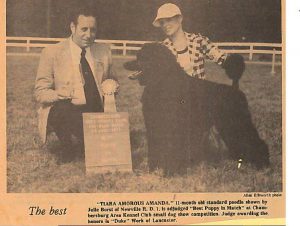
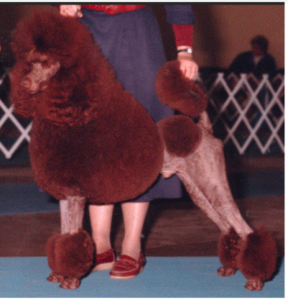

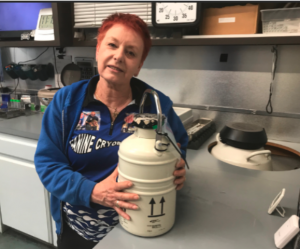
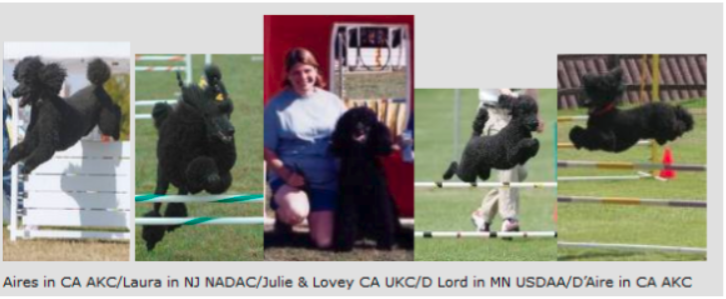
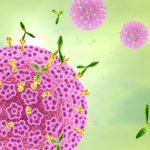 Previous Post
Previous Post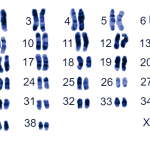 Next Post
Next Post


